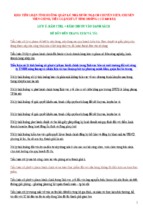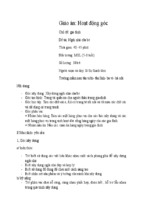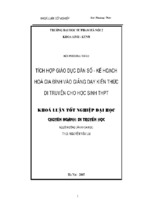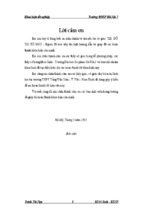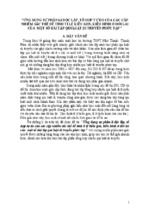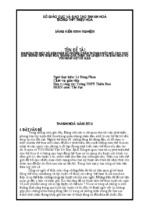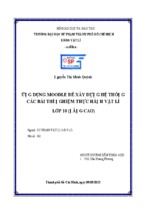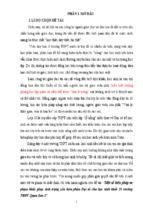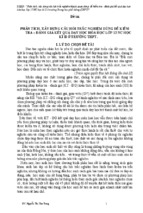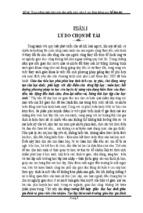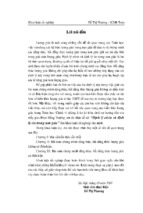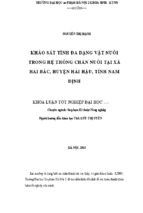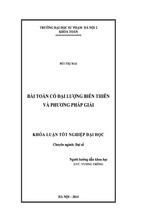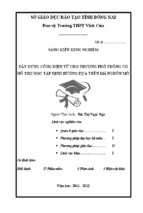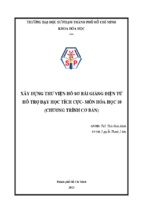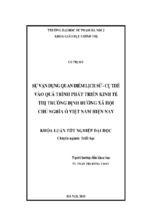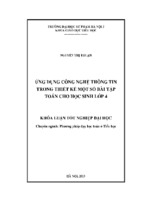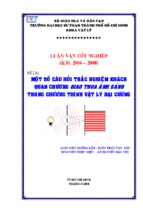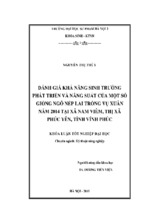PART I: INTRODUCTION
1. Reasons to choose the theme .
Nowadays, English is playing a very important role in the globle development.
Therefore, the teaching of English has been improved in method of
communicative.
The importance of English is acknowledged by the Vietnamese government and
as a result of the English language programes are made compulsory beginning at
all levels of education.
Talking about the importance of vocabulary, the linguist David wilins argued
that: “ without grmamar little can be conveyed, without vocabulary nothing can
be conveyed”, indeed, people need to use words in order to express themselves
in any language. In my experience as a teacher, I noticed the fact that students
usually find It difficult to speak english fluently. The main reason for such
communication Problems is lack of vocabulary. Students are often confronted
with the problems of Forgeting the words immediately after the teacher has
elicited their meaning or after They looked them in dictionary, and this also
cause of the lack of vocabulary.
As an English teacher I know the importance of English with my students, so
I always try to find out the best methods in teaching English for them. In our
school system, English is both different and characteristic subject. It makes
students curious and passionate. However, it also creates a lot of difficulties and
misunderstandings. As a result, students sometimes feel discouraged. In this
situation, teacher has a very important role to transfer the passion and the
enjoyment to students.
When teaching English at high school, specially teaching the 10th grade at
Thach Thanh 2 high school, I see that most of my students like learning English.
They also try their best to learn it in all skills and language focus but they seem
indifferent to other skills. Learning vocabulary is a very important part of
learning a language. The more words you know, the more you will be able to
understand what you hear and read and the better you will be able to say what
you want to speak or writing. Proficiency in English depends on the knowledge
of its vocabulary possessed by the second and and foreign language learners and
even the native speakers. Students with a low vocabulary knowledge show weak
academic performance in different courses related to language skills such as:
speaking, listening, reading and writing.
It is enthusiasm and career passion that motivate me to write this experience
innovation with aims to share some of my opinions on topic related to teaching
vocabulary for grade - 10 students as well as to help both my colleagues and my
students partically remove the difficultly when teaching related lesson. For this
reason, i decide to choose the theme : “IMPORTANCE OF VOCABULARY IN
LANGUAGE LEARNING AND HOW TO BE TAUGHT AT 10C4 AND 10 C6 THACH
THANH 2 HIGH SCHOOL”.
1
2. Purposes of the research.
The main purposes of the research are: to offer some solutions with the hope of
- Helping students understand the meaning of new words.
- Helping students enrich and practice a wide range of vocabulary.
- Helping students improve reading comprehesion.
- Helping students know how to express themselves in writing.
- Bolstering students’ ability to grasp ideas and think more logically.
- Providing reference materials for teachers or students who intend to master the
language of English or want to make their English more natural and more fluent.
3. Methods of the research.
To make my solutions effectively, I have used some following methods :
Firstly, I always get advices from my colleagues through co-working.
Secondly, I usually study, create and use new methods in teaching English such
as using images, pictures, posters, real objects, etc .
Thirdly, I apply science and technology in teaching, use projecters, presents
films, video clips to make the lesson actively, to motivate the spirit of studying
between students.
Lastly, I design some activities for students to discuss about the topic releated
to the lesson to enrich and enhance the vocabulary.
4. Objective and Scope of the research.
I do the research to know about the fact of teaching and learning vocabulary
in Thach Thanh 2 high School more practically. This study also investigates
whether the techniques can have positive effect on students or not. Can the
methods help my students enhance comprehension, locate unfamiliar words in
a story, use vocabulary in reading, speaking, listening and writing ?
The total participants were 85 students from the tenth grade 10 C6 and 10c4
of the school year: 2019- 2020 at Thach Thanh 2 high school , which is situated
in Thach Thanh, a mountainous district in Thanh Hoa province. The majority of
these students come from disadvantageous families with the under medium level
of living standard and learning condition as well. Consequently, these students’
motivation of studying is remarkable limited due to the burden of subsistence.
Unfortunately, their English proficiency is almost either at the beginning level or
at A1 level although they have been learning English for more than four years,
since they were sixth grade students.
PART II: PROBLEM SOLVING
1. Theoretic basis of the problem
As mentioned, vocabulary is vital to communicate with others and
understanding what one is reading. It appears in every skills of language
listening, speaking, reading and writing skill. Many peope realize that their
vocabulary is limited so they have difficulties in expressing ideas. Enriching
vocabulary is very important for the students who learn English as a foreign
language. That is why everybody who learn English or a certain language should
know the words. Building a better vocabulary of English language is one of the
most important things to do. Adequate vocabulary is the basic need to manage
2
almost all the aspects of every life efficiently, while by educated vocabulary,
one can gain confidence in in speaking publicly.
Having a good vocabulary to draw from can help students write more
effectively. Students need to use more formal tone when writing not
conversational language and to do that. Students need richer vocabulary to tap
into those words that they used when speaking.
Recent research indicates that teaching vocabulary may be problematic
because many teachers are not confident about the best practice in vocabulary
teaching and at times do not know where to begin to form an instructional
emphasis on word learning (Berne & Blachowicz, 2008). Teaching words is a
crucial aspect in learning a language as languages are based on words
(Thornbury, 2002). It is almost impossible to learn a language without words;
even communication between human beings is based on words. Both teachers
and students agree that acquisition of the vocabulary is a central factor in
teaching a language (Walters, 2004). Teaching vocabulary is one of the most
discussed parts of teaching English as a foreign language. When the teaching
and learning process takes place, problems would appear to the teachers. They
have problems of how to teach students in order to gain satisfying results. The
teacher should prepare and find out the appropriatetechniques, which will be
implemented to the students. A good teacher should prepare himself or herself
with various and up-to-date techniques. Teachers need to be able to master the
material in order to be understood by students, and make them interested and
happy in the teaching and learning process in the classroom. The teachers should
be concerned that teaching vocabulary is something new and different from
student’s native language. They also have to take into account that teaching
English for young learners is different from adults. The teachers have to know
the characteristics of his/ her learners. They moreover need to prepare good
techniques and suitable material in order to gain the target of language teaching.
This research is carried out with the hope of supplying a good material for both
teachers and students in their teaching and learning vocabulary
2. 2. Practical basis of the problem
Thach Thanh 2 high school is one of the mountainous schools in Thanh Hoa
province. People mainly live on rice and sugar canes, the living standard is very
low. As a result, students have not had much good chance of studying and using
English until recently. Students (and even their teachers) do not have an English
environment to practise. There has not been an even class for group D or A1
because most of the students here take part in the others groups such as: A, B,
C. Learning English here has not still been really important to students and
people. As common in other high schools in Vietnam, the students in this school
have to take English as a compulsory subject in the curriculum and study it three
periods a week ( 1 period = 45 minutes), for 37 weeks a year, moreover,
English, Maths, literature are core subjects, which are compulsory in the
national examination at certain stages of school education system, Therefore,
teachers have so much difficulty in teaching English .
3
Working as a teacher for a long time, I myself understand the nature of the
problem and usually find it necessary to find out the ways to improve the
situation. I try my best to do this research with a view to getting my students and
other teachers to benefit from it by giving them more opportunities to practise
and to better their English. In reality, most students find it difficult to learn
English. As a result, they become passive and afraid to learn it. Some other
students feel a little bored with English classes because they have to remember
vocabularies or structures mechanically.
Applying methods of teaching vocabulary in English classes is an effective
solution to motivate students, to make them interested in the lessons and to love
English more.
3. Solutions to the problem
Language is means of communication that is made up of sentence that conveys
meaning. At school learning language means learning vocabulary. It means that
vocabulary takes an important part in language in which vocabulary will make a
language meaningful. I see that when teaching vocabulary the teachers should
focus on.
- The form: Teacher need to know whether if it is a verb/ a noun/ an
adjective / an adverb to be able to use it effectively.
- How it is spelt: it mean the words should be clarified pronunciation before
being shown the written forms.
- How it is pronounced: It is very crucial to use the phonemic script so the
students can highlight the word stresses.
- If it follows any unpredictable grammatical patterns. For example (manmen, child- childen, …..)
- How the word is related to others. For example: synonym, antonyms,
lexical sets.
- Collocation or the way the words occur together.
To help my students improve the ability of using vocabulary well, and taking
deep investigation into this problem, I have found out some useful measures to
deal with this problem.
- For students who have low English vocabulary, school leaders or teachers
need to increase more periods out of the curriculum in school.
- Teachers need more than an illustration which is accurate, concise and vivid
for each .
- Teachers try the best way to find out the most effective technique of
learning
vocabulary for learners on the reality of the problems: for example , teachers
should prepare which words should be taught, the words are used most often
throughout the text or the ones that are key to understand the main aspect of
the text.
- For homework, besides asking students to do exercises in textbooks,
teachers should have available amount of tests related to the topic.
4
PART A: THEORY OF VOCABULARY
The theory of teaching and learning vocabulary is so complicated and it makes
students confused. To help my students gain benefits from the lesson. When
teaching vocabulary, I always consider the 4 following points:
- Definition of vocabulary.
- Why teaching vocabulary is necessary?
- Why the students often forget vocabulary ?
- Techniques to teach vocabulary:
A. Definition of vocabulary.
Vocabulary ( from the Latin for “ name” also called wordstock, lexicon, and
laxis ) refers to all words in a language that are understood by a particular
person or a group of people .There are two main types of vocabulary: active and
passive. An active vocabulary consists of the words we understand and use in
everyday speaking and writing. Passive vocabulary is made of words that may
recognize but do not generally use in the course of normal communicatinon.
From the definitions above, it can be concluded that vocabulary is the total
number of words that are needed to communicate ideas and express the speakers'
meaning. That is the reason why it is important to learn vocabulary.
B. Why teaching vocabulary is necessary?
Vocabulary plays a fundamental role in teaching and learning a foreign
language. It is the basic for the development of all other skills like reading
comprehension, listening comprehension, writing, spelling, pronunciation.
Vocabulary is the main
tool for students to use English effectively when he/ she is confronted with a
native English speaker, when watching movie or when listening to a favourite
song in English, when reading a text or when writing a letter to a friend, students
always need to operate these words.
C. Why do students often forget vocabulary?
Students are taught hundreds of words but they do not remember them all.
This is the biggest challenges that encounter teachers while teaching vocabulary.
Teachers assume that once a word is taught, it has tobe learnt and remember as
well because they do not use the word immediately and sometimes because they
do not understand it correctly.
From the reasons mentioned above, I have found out some useful techniques
in teaching vocabulary which will be presented as below.
D. What should the teachers do before teaching vocabulary.
1. Good preparation.
Before starting a new lesson, the teacher must have good preparation. He/she
should prepare a list of new words appearing in the reading that are neccesary to
teach students in order to do well in the reading. And he/ she should make the
teaching learning vocabulary process clear and easy for students to remember.
With good performmance of teaching vocabulary, students will be motivated for
the tasks in the next part: while-reading and post-reading that leads to a good
5
and successful lesson for both students and the teacher. However, teaching
vocabulary is not just conveying the meaning to the students and asking them to
learn those words by heart. If the teachers believe that the words are worth
explaining and learning , then it is important that they should do this efficiently.
Teachers should use different techniques and activities in teaching English
vocabulary to motivate their students, enrich their vocabulary and enable them
to speak English properly as well as do the reading comprehension well.
2. Choose the words to teach
Normally, a reading text always appears some new words, but it is not
neccesary to teach all of them and teach them in the same ways. The teacher
should choose words which need teaching. Choosing words to teach, the teacher
has to consider whether they are active or passive words.
- Active words are words which students know and use in communicating or
writing.
- Passive words are words which students only know and understand when they
read a text.
The ways to teach two forms of words are not the same. Active words relate to
4 basic skills: Listening, Reading, Speaking and Writing. The teacher, therefore,
needs to spend more time presenting and practising, specially the ways to use
words. To passive ones, however, students can only know and students don’t
need to spend much time using them, So the teacher should choose and decide
which words are taught as active or passive ones. To save much time, the
teacher always endures what he/she will teaches – words students haven’t
known.
To avoid teaching words which are unnecessary, the teacher should check
students’understanding by asking some questions or asking students to give
examples with the new words. And the teacher can ignore if the words are
difficult and strange and they are not related to the passage. Teachers also
should encourage students to guess the meaning of new words if the words are
important and easy in the passage.Teacher should mark the words he/she can ask
students to guess. However, the teacher has to show students ways to guess the
meaning of new words by reading words near new words carefully and check
affixes. This not only helps students to know more about the new words and
their part of speech such as nouns, verbs, adjectives, adverbs…by themselves
but also encourages them to have good habit in reading in stead of stopping
reading to look up the dictionary.
3. Choose the techniques to teach vocabulary
Learning a language is basically a matter of learning vocabulary of that
language. Not being able to find the words to express ourselves is the most
frustrating experience in speaking another language. English learners come from
difficult cutures, languages, castes, religions. they can not understand
explanation made in the target language. Likewise, if the teachers teach by
translating in their native language, which interfere with influency. Teaching is
a challenging job therefore,
6
the teachers who teach vocabulary should use different teachniques for learners
mentioned as below.
3.1 Using pictures
Pictures as a part of visual aids are used as a technique in teaching English
vocabulary. Pictures used to explain the meaning of vocabulary items can be
posters, postcards, flashcards, graphs, family photograph, maps or even board
drawing… With easy words, students can immediately guess the words but with
some difficult ones, students have to imagine and make a connection from the
image to the words. Anyway, pictures help motivate students and make them to
pay attention and take apart.
Example for illustration: English 10: Unit 1- Reading – vocabulary
- Vocabulary: buffalo, field, harrow, peasant, do transplanting
- illustrative pictures:
This is the buffalo
The peasant is harrowing
The farmers are doing transplanting in the field
- Vocabulary: Dolphin, Endangered species( unit 9- Undersea world)
7
Dolphin
Endangered species
In this technique, teacher shows the pictures one by one and asks students
questions related to new words.
Example the way the teachers show the words: buffalo, harrow, field
Teacher : what is this ?
Students: it is a ( buffalo, harrow, field)
Teacher: what does the word ( buffalo, harrow, field) mean?
Students give the answer to the meaning of the word buffalo ( harrow, field )
By looking at the pictures, students can easily find out the meanings of these
words and phrases.
Example for illustration: English 10: Unit 12- Reading – vocabulary
The teacher show the phrase: Lull baby to sleep
In this way teacher shows the picture and asks the question:
Teacher: what is the mother doing?
The students: She is lulling the baby to sleep.
3.2 Using realia
Example for illustration: English 10 Unit 5- Reading – vocabulary
- Vocabulary: + different parts of computer systems
- Realia: keyboard, mouse, speaker, CPU, floppy disks CD Roms, VDU (we can
use toy items instead of real items)
8
When teaching these words, teacher show students real objects and let them
get the meanings of these words. With real objects, students will find it easy to
learn vocabularies and they will be more interested in the lesson. Teachers will
have probably realized by now that including realia into classroom involves a
great deal of preparation in some cases. Is it really worth you time? The answer
is yes. And your students’faces will be living proofs.
3.3: Using body language
Example for illustration: English 10: Unit 4- Reading – special education
- Vocabulary: + raise both hands
+ open up fingers
+ close fingers
The teacher is raising both hands.
- Body language: Teacher use his/her actions or gestures to mine these words.
After each action, students will tell the meaning of the words the teacher has
mined
actions and gestures will be able to facilitate communication, understanding and
participation. Additionally, actions and gesture will make you appear to be a
more charismatic teacher. Putting yourself out there, fearlessly, demonstrates
confidence.
9
Your students will therefore be more engaged and more likely to retain what
they’re being taught in the classroom.
Using body language, actions or gestures is also a good way to motivate students
in studying especially in learning vocabulary because this technique can make
them not feel bored. Students can have good memory about vocabulary because
it relates with part of human body. Therefore, they can be easy to remember it.
3.4. Drawing
Objects can either be drawn on the blackboard or drawn on flash cards. The
latter can be used again and again in different contexts if they are made with
cards and covered in plastic. They can help young learners easily understand and
realize the main points that they have learned in the classroom.
Example: when teaching in unit 4- English 10 in part A( Reading). The teacher
can use chalks to draw some Maths symbols on the blackboard to help mentally
retarted students understand some new words in reading as below:
+ Add
- Subtract
: Divide
× Plus
3.5. Using spoken languages
With this technique, teacher can use definition forms, synonyms or antonyms
to show the meaning of new words.
Example: In Unit 1 – Part A: Reading
When teaching the word “ peasant” or “ occupation “ teacher can use synonym
to help students know its meaning: farmers = peasants, occupation= job
Example: In Unit 10 – Part D: reading, writing
To introduce and show the meaning of the word “married”, teacher can use
antonym: married ó single( part D- writing)
crowedó emty
3.6. Using prefixes, suffixes, root words
With many words in English, teacher can use prefixes or suffixes to show the
meaning of new words. By using this way, teacher can use some usual prefixes
such as un-,il-, dis-, re-…or suffixes such as -able, -er, -or, -ty, -less… to teach
different parts of speech.
Furthermore, teacher can use root words to teach vocabulary. Try to use
common roots with common words. This way must be repeated and repeated
day by day. Teacher ought to do it slowly and frequently. Some common roots:
trans (move, go) such as transport/ translate, pect (see): such as respect/ expect
Example: In unit 2 : school talk – Part A: Reading
Teacher uses prefixes : “in-” to teach students the word inconvenient
Teacher uses prefixes : “un-” to teach students the word uncrowed
Example : In unit 4: special education- Part A: Reading
10
Teacher uses suffixes “ tion” to make Noun from given verbs
Demonstrate ( v) → demonstration ( N)
Oppose ( V) → opposition ( N)
Example: in unit 4: Special education- Part A: listening
Teacher uses the root word “ photograph “ to teach vocabulary
photograph
- photographer ( N): the person who takes photograph
- photogenic ( Adj): looking attractive in photograph or on film
- photography ( N): The art or practice of taking and processing photographs
- photographic( A) : relating to or resembling photographs
3.7. Translating
With words which are too difficult to use one of the above techniques, teacher
can give students their Vietnamese equivalents in meaning after introducing
them.
Ex: In unit 13: films and cinema – the word “ sequence” = chuỗi
3.8. Gap - filling
In this kind of task, teacher prepares a list of sentences with a missing word in
each one. The words for students to fill in are the ones the teachers has just
taught. This activity can help students not only remember the words they have
learnt but also know how to use the words in specific situations.
3.9. Matching
Matching is a widely used activity among 3 stages: pre-reading, while-reading
and post-reading and it is quite easy to students. There is a variety of tasks.
Teachers can choose one that is suitable for their students and this also depends
on what the words are. Follows are some samples of matching tasks for teachers
to choose:
- Matching the words with their definitions.
- Matching the words with the right pictures.
- Matching the words with their meanings.
- Matching the words with synonyms.
- Matching the words with antonyms.
Example: Match the words in column A with the meaning in column B( unit 9:
English 10- undersea world)
A
B
1.Carnivores
a.The variety of life in the world or in
a particular habitat or ecosystem
2. Biodiversity
b. A ship that can travel under water
3. Gulf
c. A child or animal in relation to its
parent or parents
4. Submarine
d. A large area of sea that is partly
11
surrounded by land
e. Animals that eat meat
5 .Offspring
Suggested answer: 1e, 2a, 3d, 4b, 5c
3.10. Guess meaning from the context
While reading, language learners may confront with unfamiliar words in
context. Encounter a few words may not block in general comprehension of the
text. However ,when readers are not acquainted with numerous or the most
essential ones in the text their reading comprehension may be impaired .words
Guess meaning from the context refer to the ability to infer the meaning of an
expression using contextual clues. These clues may be purely linguistic or
situational. The best way to help student guess the meaning from the text is to
use antonym and synonym.
Example 1: Marry curie worked very hard, she earned a degree in Maths with
flying colours. (Unit 3: people’s background- English 10)
A. very well B. difficultl
C. badly D. easily
Example 2: Music is an integral part of life. The word integral means
_________
( unit 12- Music: English 10)
A. unnecessary
B. essential C. impolite
D. encouraged
3.11.Multiple – choice questions
Multiple – choice questions require students to identify the right answers from
among a set of possible options that are presented to them. To create valid
multiple
choice items for checking not only vocabulary but also grammar. teachers
should
use single, clearly – stated questions including a total of 3 to 4 options. It may
take time for teachers to construct good multiple – choice items. Teachers,
however, can sometimes use this activity to motivate their students.
Example: Choose the best options A, B,C,or D to complete sentences ( unit 12English 10: Music )
Question 1: I find this work very____________________.
A. Tire
B. Tiring
C. tired
D. Tires
Question 2: No one can avoiding getting______________listening to her.
A. confuse
B. confuses C. confused
D.confused
Question 3: Amy gave a lyrical_____________ of her experience in the South
seas.
A. Describe
B. Describing C. Descriptive D. Description
By designing this activity, the teacher not only check students’ knowledge of
Attitudinal adjectives but also grammar correctly. ( Question 1 and 2 help
students recognize adjectives end in” ing” or adjectives end in” ed”, Question 3
checks students’ grammar, they need to fill in the blank with a noun as a rule: a/
an/ the + adj+ Noun.
12
3.12.Mindmap
A mind map, or spidergram, is a strategy for making notes on a topic, prior to
writing. It is a structured strategy, which shows the (hierarchical) relationship of
ideas, as opposed to an unstructured strategy, such as brainstorming, in which
students produce notes at random on paper.
Making a mind map should be a spontaneous pre-writing activity. Students
start with a topic at the centre and then generate a web of ideas from that,
developing and relating these ideas as their mind makes associations. Mind
maps work well as their visual design enables students to see the relationship
between ideas, and encourages them to group certain ideas together as they
proceed. Mind maps work especially well when created in groups, since the
discussion this engenders aids the production of ideas, and makes the task
livelier and more enjoyable.
3.13. Using games: Games such as bingo and concentration
Games are often used as short warm-up activities or when there is some time
left at the end of a lesson. Using games is one effective and interesting way that
can be applied in any classrooms especially English classrooms.
Games help students to make and sustain the effort of learning. They provide
language practice in the various skills- speaking, writing, listening and reading.
They also encourage students to interact and communicate and create a
meaningful context for language use.
This activity is a good way to help students memorize new words as well as
make them more interested in the lesson. After presenting the new vocabulary
and building up a list on the board with their Vietnamese equivalents, teacher
follows the following steps to get students to play it:
PART B: ACTIVITIES ON TEACHING AND LEARNING VOCABULARY
A long with teaching and showing the meaning of new words, activities for
checking vocabulary after that are very important to help students remember the
words they have learnt in the class and know how to use them corrrectly. An
interesting and appropriate activity with students’ level will help stimulate them
in the next stages of the lesson. The activity teacher chooses for his/her students
do should be based on what the words in the lesson are and students’ level as
well as their interest. teacher should create suitable and useful activity for
checking vocabulary after instructing them to pronounce the words correctly.
Teachers can apply some popular and effective activities for assessment of
experimental results as follows:
Activitiy 1: The teacher prepare some questions related to the vocabulary they
have learnt in the text book English 11 to check their grammar and the ability to
use vocabulary, In this task the teacher ask student to work individulally.
Choose the correct answer: A, B, C or D :
13
1. A period of ten year is called_______.
A. decade
B. century
C. millennium
D. Thousand
2. Charlie chaplin has been the most famous movie stars of all time
in____film
A. silently
B. silences
C. silence
D. silent
3. The word spectator has the same meaning as_____
A. Audible
B. Audience
C. Audio
D. Automatic
4. The opposite meaning of common is _____
A. Usual
B. Ordinary.
C. Rare
D. popular
5. Listening to English songs on the radio is one of the best ways to______
your listening skill.
A. Improve
B. Improvement. C.Improving
D. Improves
6. computers are wonderful_____machine which speed up calculation.
A. calculating
B. lighting C. Accurating
D.producing
7. Rapid run - off would cause frequent floods and leave little water during
dry season. The opposite meaning of Rapid is________.
A. quick
B. Slow
C. fast
D. Mass
8. In Quoc Tu Giam there are turtles with the names of ____on its back.
A. Scholars
B. schools
C.scholarships
D. schooling
9. Choose the word whose has underlined part is pronounced differently?
A. Pleasure
B. Mature
C. Measure
D. Architecture
10. Which world has a different stress pattern from the others?
A. Transmit
B. Allow
C. request
D. cancel
Activitiy 2: The teacher ask students to work in pairs by using some suggested
words and phrases they have learnt to make a dialoge related to the lesson.
Teachers give student time to do the task and call out some pairs present in
front of the class. Through this task, it is easier for the teachers to check
students grammar, spelling, pronunciation, intonation and the use of language
flexibly.
For example: In unit 12- Music ( English 10 page 124) part B : Speaking
- kind of music :………………..
- Favorite bands
- Favorite singers:………………..
- Reasons to listen to music:…………..
- When to listen :………………………
A sample conversation of 2 students in 10 C6 class - Thach thanh 2 high
school.
They are speaking English related to the topic given under the
observation of the teacher.
14
Diu: Hello, Hoa. Do you often
listen to music?
Hoa: Hi, Mai. I am a big fan of
music.
Diu: What kind of music do you
like?
Hoa: well, I really like Pop
music.
Diu: Me too. Why do you listen
to music?
Hoa: I listen to music to relax
myself, sometimes I listen to
music to
learn foreign
language.
Diu: Can you tell me some
favourite bans, you know?
Hoa: uhm, l don’t really remember some bands but Backstreet boys is my
favourite one.
Diu: When do you often listen to music?
Hoa: I often listen to music when I’m out, sometimes before going to bed.
Diu: yes. That’s a great idea. Good bye, Hoa
Hoa: See you later.
Activity 3 : After teaching new words from unit 1 to unit 3, Teachers ask
students use the following vocabulary to fill in the blanks.
contented, humanitarian, crowed, frightening, flying colours
1. Many ________organizations are trying to help people in the earthquake
areas.
2. Though I’m not perfect, I’m __________with whatever I do.
3. It was such a___________experience that all of us would never forget.
4. Every day my brother has to ride his bike in narrow and________street to
get to school.
5. In spite of her difficult living condition, Marrie curie worked extremely
hard she earned a degree in Physics with_________________.
Suggested answer:
1. humanitarian
2. contented
3. frightening
4. crowed
5. flying colours
Activity 4: playing game .
After presenting the way to pronounce the 2 sounds / i/- /i:/ in part E- English
10
15
Teachers hang out some pictures on the board and ask students to work in
groups to match the pictures with the corresponding sound. The class is divided
in to 4 groups: group A, group B, group C, and group D. When the time is over,
the teacher will call out some representatives for each group to give their
answer. The winner will be the first to finish the task with the correct answer.
Picture 1
picture 2
16
picture 3
picture 4
picture 5
picture 6
picture 7
picture 8
Suggested answer.
17
/i/
/ i: /
Ship( picture 2)
Sheep ( picture 1)
Film( picture 4)
Bean ( picture 8)
Cinema( picture 3
Cheese ( picture 6)
Fish( picture 7)
Meat( picture 5)
Activity 5: Using mind map in teaching vocabulary
Example: when teaching unit 9: Undersea world – English 10. The teachers use
the key word ” Undersea World “ and ask students to work in groups to find out
vocabulary related to the given topic. In this way, students will focus on the
topic and enrich vocabulary easier.
Ocean
shrimp
dolphin
UNDERSEA WORLD
Shark
Starfish
Fish
submarine
4. The assessment of experimental results of the research
4.1. Findings of the research
Over a year of teaching, two classes have been chosen to do the research: the
participants were 10C 4 and 10C6. I found that, my students paid more attention
to the lesson, the ability of doing the test better, the ability to use vocabular to
speak English in daily life more perfectly. Some errors about using vocabulary,
especially special cases of word formations have been limited remarkably.
This study was used in the school year 2019- 2020 at 2 classes: 10 C4, 10 C6
at Thach Thanh 2 high school and the result was collected as the following:
Before applying the techniques
18
Class
The
Very
Rather
A
little Not
number of Intersted in interested in interested
interested
students
English
English
in English in English
10C6
43
3 (7 %)
7 (16 %)
10 (23%)
23 (53 %)
10 C4
42
2 ( 6%)
8 (19%)
9(21%)
23 (54%)
After applying the techniques
Class
The
Very
Rather
A
little Not
number of Intersted in interested in interested
interested
students
English
English
in English in English
10C6
43
11 (26 %)
10 (23 %)
10 (23%)
12 (28 %)
10C4
42
12 ( 29%)
11 (26 %)
9(21%)
10 (24 %)
Comparing with old methods I had applied to my students before that and
after using new methods in pre-reading, I can present some changes in my
students’ attitude and results as follow:
Before
After
- Students didn't work effectively
because new words they got from
teacher difficult to remember and they
were confused with other new words
they didn’t know in the text. So they
weren't motivated.
- Students weren't motivated.
- Students' attitude for the lesson
wasn't good. They felt bored and
confused when dealing with new
words so they weren't active in their
lessons.
- Students' result for the lesson wasn't
good. Because most of them couldn't
complete their tasks
- students worked effectively.Teacher
elicites new words in interesting and
fascinating ways and they knew
strategies to not worry about any
other new words they met.
- Students were motivated.
- Students felt interested and excited
because they were active in a lot of
activities during the lesson.
- Students’ result for the lesson was
good because most of them completed
their tasks well.
4.2. The effectiveness of the study in comparison with the previous
methods
The research results above show that doing the researches not only helps the
students understand the lessons well but also have a good chance to practise
what they have learnt. To achieve this requires the teachers need to invest time,
effort and intelligence to discover treasures of knowledge. It is also necessary
19
for the teachers to select proper methods so that they can promote the students’
proactive ability in learning English.
There are different methods of teaching English, but the most important thing
is that we must use the one that works in a certain situation. Actually, various
activities in each lesson can help with making students more dynamic and
active. What I will do is to make effective use of all four skills: listening,
speaking, reading and writing. I can teach speaking through reading, listening,
speaking, and writing and vice versa. One more important thing I should do is
implementing task-based teaching. Tasks must be varied, challenging and
interesting enough to hold students’ interest in communication. Tasks must also
be relevant to students’ needs, such as their jobs or target situations
However, not all students can achieve the desired result because it is really
difficult for students to remember new words and use them flexibly. I myself
usually adhere to the principal that it is better if I teach my students essential
things and things that motivate students so that they can gain the best result from
their teaching.
PART III – CONCLUSIONS AND RECOMMENDATIONS
1. Experimental lesson
Learning is a personal journey.We are simple guides. our students have to do
the traveling. A guide can’t force a tourist to see what he or she doesn’t want to
see. We organize the environment, but We can not learn for them, Therefore,
they have to do the learning themselves. So the teachers should teach the
essential things and prepare interesting lesson plans that motivate students to
get the best result.
Teaching is a really difficult task. The teacher must have good knowledge,
skills and other factors to adapt to education environment, so the teachers should
be plexible, creative Tasks or activities should be applied for different levels of
students, different classes.
This piece of work aims to highlight the importance of vocabulary learning as an
essential part in foreign language learning. Although it has been neglected for
many decades, during the 80s it became a 'hot' topic for researchers. Lexical
knowledge is central to communicative competence and to the acquisition of a
second/foreign language and a lack of vocabulary knowledge is an obstacle to
learning. An attempt is made to review the trends in the area of teaching
vocabulary through various techniques teachers use when teaching . Before
presenting the meaning or form of vocabulary items, teachers need to notice the
type of the vocabulary, the students’ level and characteristics, and also the value
of the techniques for the learners. In other words, students' age, level of
education as well as English proficiency... Etc may affect their learning, so
teachers need to be aware of these differences when applying their teaching
technique’s. They can further provide their students with vocabulary learning
strategies with opportunities to encounter words repeatedly and in more than one
context. Anticipate the problems that students may have to face with such as
spelling, stress, pronunciation, kind of words such as: noun, abjective, verb,
20
- Xem thêm -

